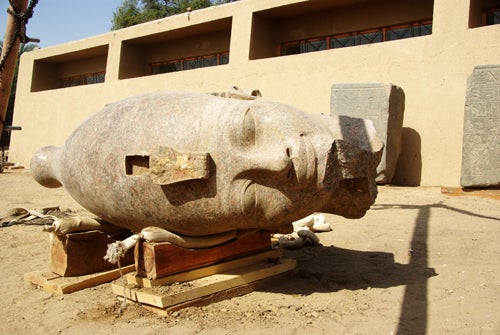Colossal head of King Tut's granddad discovered at Luxor

A multi-national team of Egyptian and European archaeologists excavating at the site of Amenhotep III’s enormous funerary temple in the Kom El-Hettan area of Luxor’s West Bank have uncovered the 3,000-year-old head of a massive statue of the 18th Dynasty pharaoh, the king of Egyptian kings, whom DNA testing has recently proven was Tutankhamun’s grandfather.
The find – made by the Colossi of Memnon and Amenhotep III Temple Conservation Project – was announced on Monday by Egyptian Culture Minister Farouk Hosni. Measuring 2.5 metres, made from solid red granite and depicting Amenhotep III wearing the Upper Egyptian white crown, it has been described in a press statement by Secretary General of the Egyptian Supreme Council of Antiquities Zahi Hawass as a “masterpiece of highly artistic quality”.
The head, added Hawass, is a “portrait of the king with very fine youthful sculptured features”. It was sheared from the body statue at the chin and neck. The body statue – fragments of which are currently in restoration – is believed to show Amenhotep III in a standing position, with his hands crossed over his chest and holding the royal insignia.
Dr. Hourig Sourouzian, Leader of the project at Amenhotep III’s funerary temple, said that more of the statue may still lie in the rubble of the enormous ruined monument, which is one of the biggest man-made structures in ancient history. Measuring 700 metres long and 500 metres wide, and covering an area of 350,000 square metres – it was ten times larger than any other mortuary monument in Egypt.
Investigation and restoration of Amenhotep III’s funerary temple is expected to take upwards of 20 years. 84 statues have been unearthed there already, among them representations of King Amenhotep III and his wife, Queen Tiye.
Queen Tiye’s mummy was recently identified by Dr Hawass and a team of scientists as part of a painstaking medical and archaeological endeavour to map the family history of Tutankhamun. The results will be revealed in the Discovery Channel’s documentary King Tut Unwrapped, which will air this Wednesday and Thursday in the UK.
The project also determined that Amenhotep III – ninth pharaoh of the 18th dynasty, ruler of Egypt between 1390 BC and 1352 BC – was King Tut’s grandfather. The boy king is believed to have been born of an incestuous marriage between Akhenaten and his sister, both the offspring of Amenhotep III.
Amenhotep was the wealthiest and most powerful of all the pharaohs of ancient Egypt. In a list compiled by American business and financial bible Forbes in 2008, he was ranked as the 12th richest person in human history.
Preview: King Tut Unwrapped, the Discovery Channel Documentary
Join our commenting forum
Join thought-provoking conversations, follow other Independent readers and see their replies
0Comments